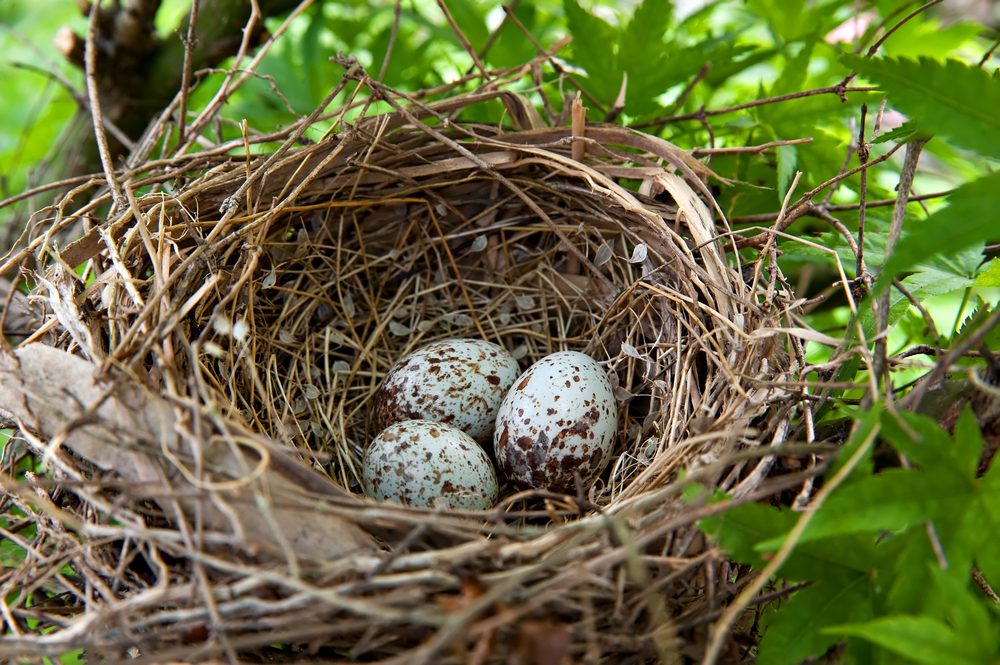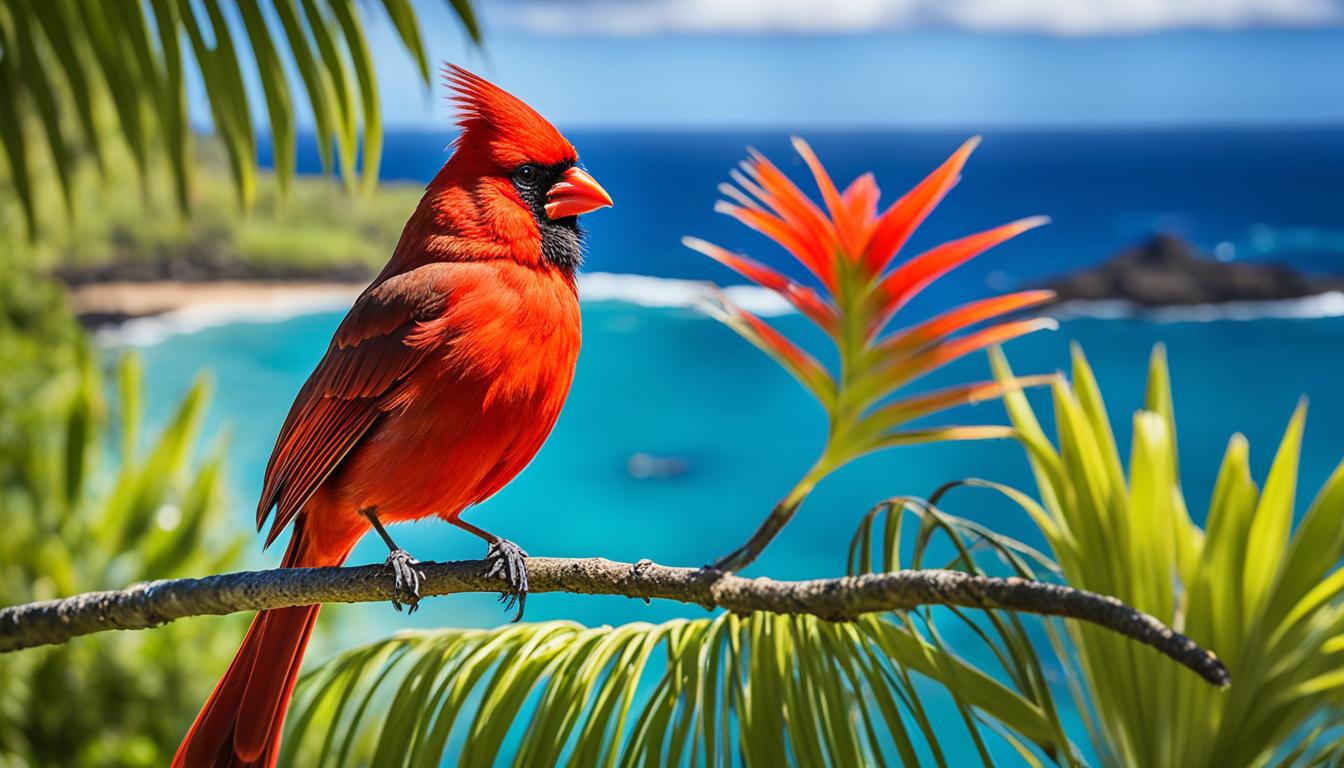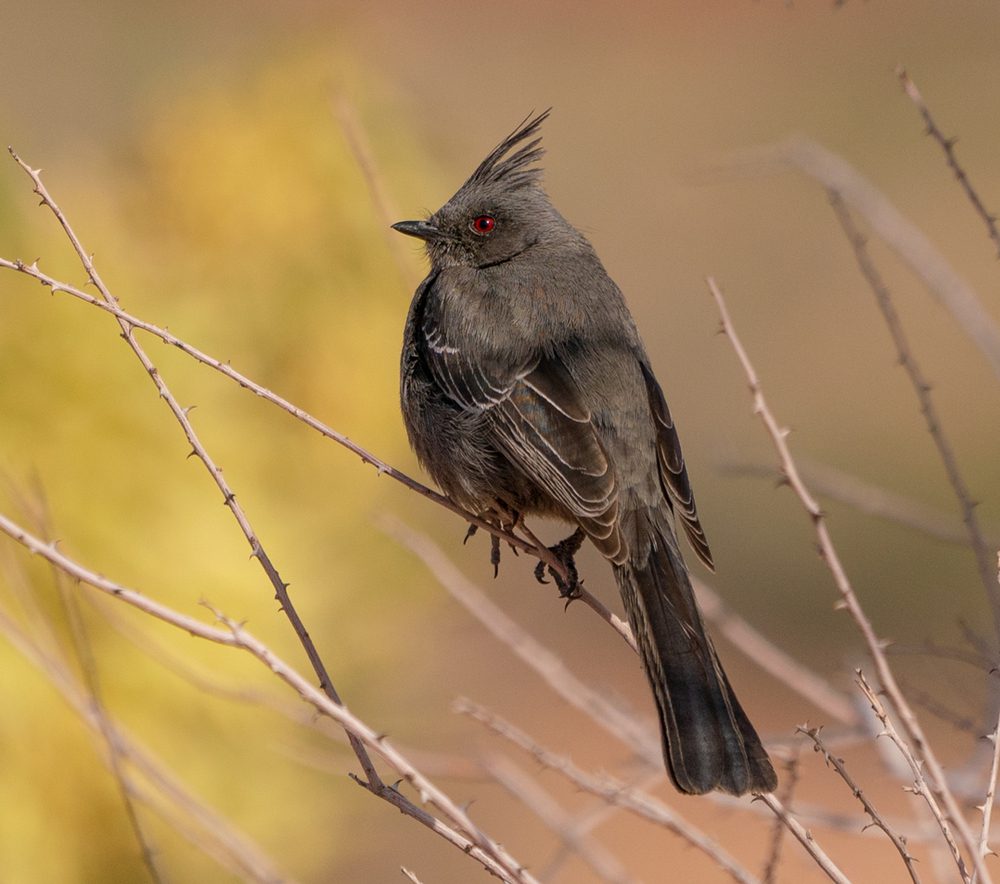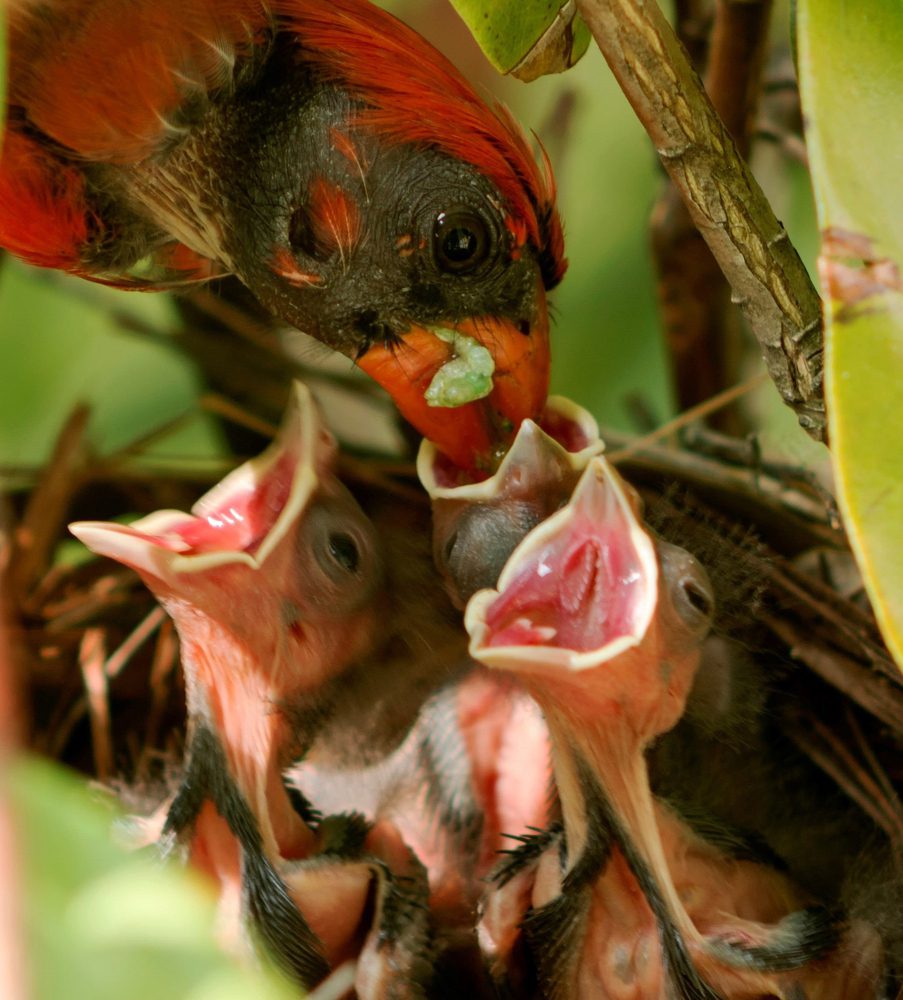Black birds in Virginia is known for its rich biodiversity, and when it comes to black birds, there are no exceptions. There is a lot of different species on Virginia. Before we dive into our list, let’s talk about identifying these feathered friends.
While ‘blackbird’ might bring to mind a single image, there’s actually a lot of variety within this group. From size and shape to song and habitat, each species has its own set of characteristics that make it special. By understanding these traits, you’ll be better equipped to spot and appreciate the nuances of Virginia’s black bird population.
Table of Contents
Types of Black birds in Virginia
1. Red-winged Blackbird

The Red-winged Blackbird is a sight to behold with its glossy black feathers and striking red shoulder patches. Commonly found in marshes and wetlands, this bird’s melodic trills and calls are as distinctive as its appearance. The male Red-winged Blackbird is particularly striking, with its jet-black plumage and bright red shoulder patches, called epaulets. These patches serve as a visual display during courtship and territorial defense.
Red-winged Blackbirds are medium-sized songbirds that measure around 8-9 inches in length. They have a stout, conical beak for foraging on seeds and insects. The females, on the other hand, have a more subdued appearance with dark brown feathers and streaks of lighter brown.
During the breeding season, which typically begins in early spring, the male Red-winged Blackbird perches on tall grasses or cattails, puffing up his feathers and belting out a distinctive song. Their song is a combination of raspy trills and high-pitched whistles that can carry for long distances. This vocalization serves to attract mates and establish territories.
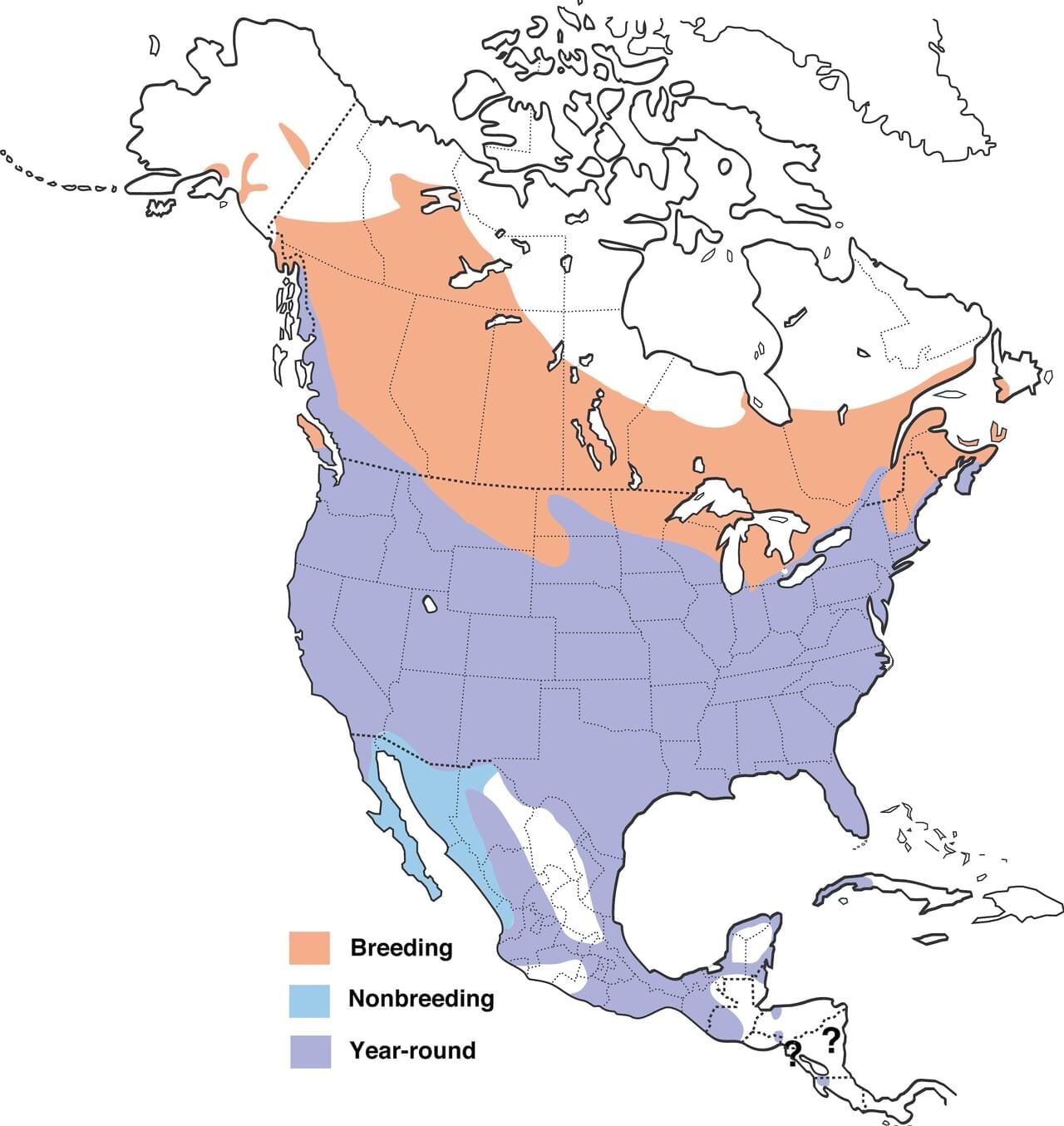
Red-winged Blackbirds are highly territorial and will defend their nesting sites vigorously. They often engage in aerial displays, soaring high into the sky while singing and then diving down rapidly to chase away intruders. Their red shoulder patches are prominently displayed during these territorial encounters, serving as a warning to other males.
These birds are commonly found in marshes, wetlands, and other freshwater habitats throughout North America. They build their nests in dense vegetation, often close to water. Females construct cup-shaped nests made of grass, leaves, and mud, usually hidden among reeds or grasses.
Red-winged Blackbirds are omnivorous, feeding on a wide variety of food sources. They primarily consume seeds, grains, and insects, but they may also eat fruits and small vertebrates. They forage on the ground or in shallow water, probing the soil or water with their beaks to find food.
In addition to their striking appearance and melodic calls, Red-winged Blackbirds play an important role in their ecosystems. They help control insect populations by consuming large numbers of insects, including pests such as mosquitoes and agricultural pests.
Overall, the Red-winged Blackbird is a fascinating and beautiful bird that adds color and song to the wetlands and marshes it calls home. Whether you spot them perched on a cattail or hear their distinctive trills, encountering these birds is always a memorable experience.
2. Common Grackle
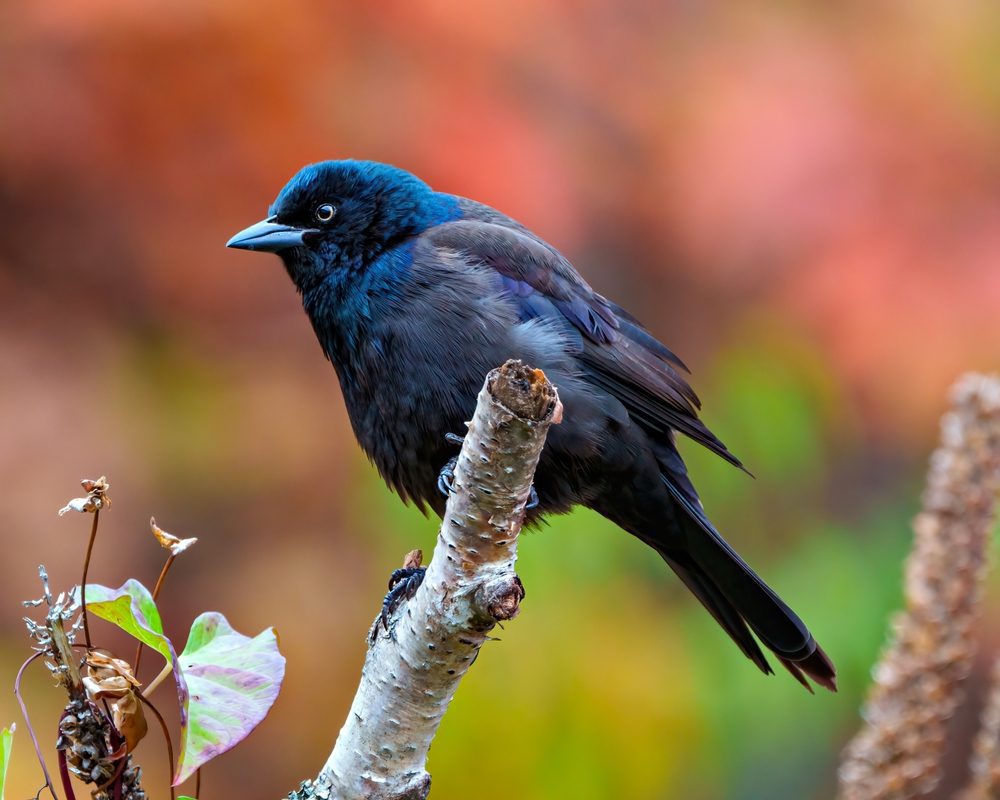

Glistening with iridescent blue and purple hues, the Common Grackle is anything but ordinary. These resourceful birds can be seen strutting across lawns and parks, often in groups, looking for their next meal.
Common Grackles are omnivorous, meaning they eat a wide range of food. They have a diverse diet that includes insects, fruits, grains, small vertebrates, and even garbage. This adaptability allows them to thrive in various habitats, from forests to suburban areas.
One interesting behavior of Common Grackles is their foraging technique. They have been observed using their bills to probe the ground for insects, flipping over leaves and rocks in search of tasty morsels. They also use their sharp beaks to catch and consume small animals like frogs and mice.
During breeding season, male Common Grackles put on quite a show to attract females. They puff up their feathers, spread their tails, and produce a variety of calls and songs. Their striking iridescent plumage adds to their appeal, making them stand out among other birds.
While some may find Common Grackles to be noisy and a nuisance due to their congregating nature, these birds play an important ecological role. They help control insect populations, especially crop-damaging pests. Additionally, they disperse seeds as they feed on fruits, aiding in plant reproduction and forest regeneration.
So, next time you see a group of Common Grackles strutting around, take a moment to appreciate their beauty and resourcefulness. These remarkable birds are a reminder of the wonders of nature that can be found even in our everyday surroundings.
3. Rusty Blackbird

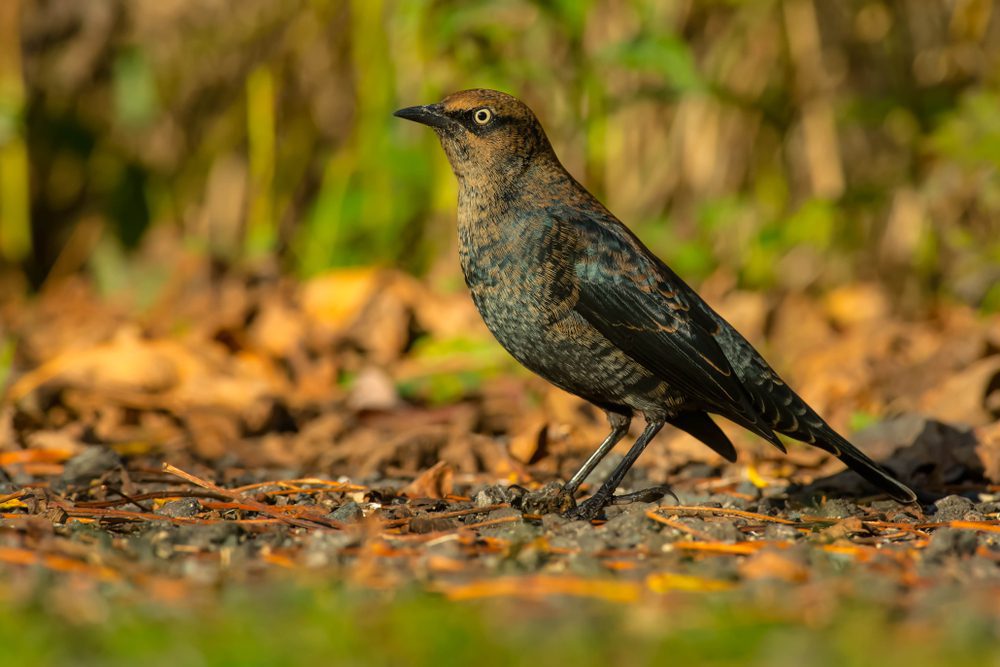
One of North America’s most rapidly declining species, the Rusty Blackbird deserves our attention. During breeding season, males sport a brilliant rusty edge to their feathers, which is how they got their name.

Rusty Blackbirds are found in the wetlands and forests of North America, primarily in the northern regions. They breed in Alaska and Canada, and then migrate to the southern United States and parts of Mexico for the winter.
These birds have a unique foraging behavior. They often feed in flocks, using their strong beaks to flip over leaves and debris to find insects and other invertebrates. They also eat seeds and berries, making them omnivorous.
Unfortunately, the Rusty Blackbird population has been declining rapidly over the past few decades. It is estimated that their numbers have decreased by 85-99% since the 1960s. The exact cause of this decline is still unknown, but possible reasons include habitat loss, pollution, climate change, and changes in food availability.
Conservation efforts for Rusty Blackbirds are focused on studying their habitat requirements and migration patterns, as well as raising awareness about their decline. Citizen science initiatives, such as the Rusty Blackbird Spring Migration Blitz, encourage birdwatchers to report sightings and contribute data to help researchers better understand these birds.
Protecting and restoring wetland habitats, as well as implementing sustainable forestry practices, are also important for the conservation of Rusty Blackbirds. Efforts are being made to create protected areas and conserve their breeding grounds to ensure their survival.
By learning more about the Rusty Blackbird and taking action to protect their habitats, we can help reverse their decline and ensure that future generations can enjoy the beauty of this unique species.
4. Brewer’s Blackbird

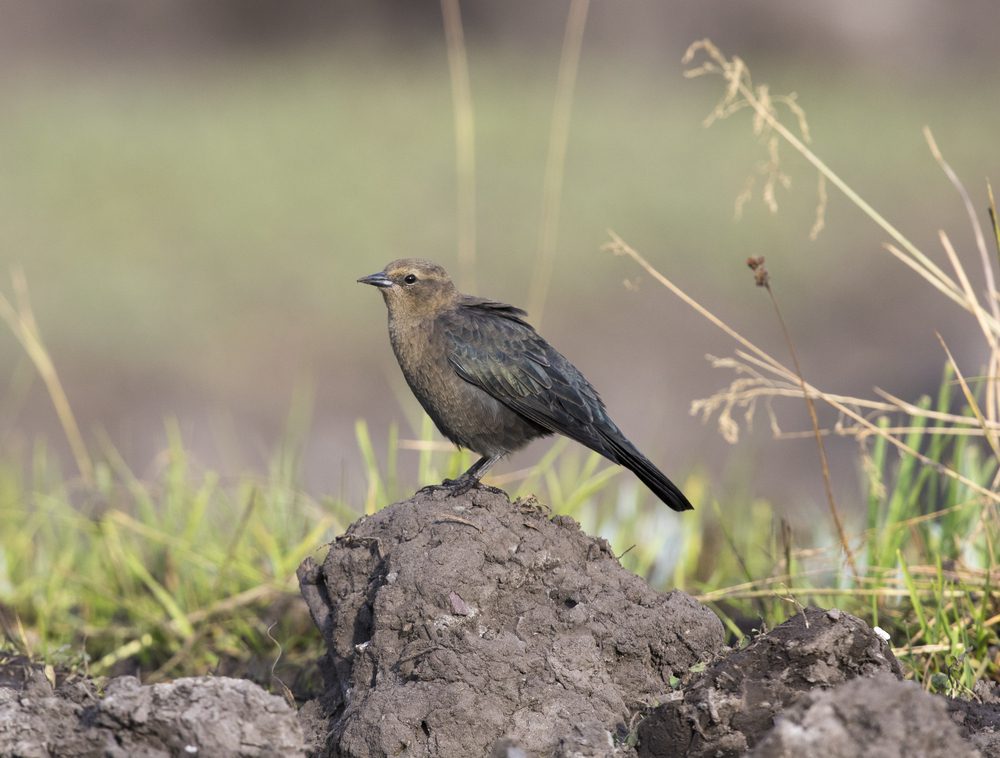
A sleek, medium-sized bird, the Brewer’s Blackbird boasts a sharp bill and keen yellow eyes. Male Brewer’s have a purplish sheen on their head, distinguishing them from other black birds.
Brewer’s Blackbirds are widespread across North America, with populations found from coast to coast. They can be found in a variety of habitats, including open woodlands, fields, and urban areas. They are often seen foraging on the ground in search of insects, seeds, and berries.

These birds are highly social and often form large flocks, especially during the non-breeding season. They are known for their vocalizations, which include a variety of calls and songs. Male Brewer’s Blackbirds also perform elaborate courtship displays to attract females.
While the Brewer’s Blackbird population is considered stable overall, there are localized declines in certain regions due to habitat loss and degradation. Conservation efforts focus on protecting and restoring suitable habitats, such as wetlands and grasslands, as well as promoting sustainable agriculture practices that benefit these birds.
By supporting conservation organizations and advocating for the preservation of natural habitats, we can help ensure the continued presence of Brewer’s Blackbirds in our ecosystems. These adaptable and resourceful birds play an important role in maintaining biodiversity and should be appreciated for their unique qualities.
5. Brown-headed Cowbird

Known for their brood parasitism, Brown-headed Cowbirds don’t build nests of their own. Instead, they lay eggs in the nests of other birds, leaving the host to raise their young. Brown-headed Cowbirds are small, stocky birds with a brown head and body, and a dark blackish-brown color on their wings and tail. Males have a glossy black body with a brown head, while females have a more dull brown coloration overall.

These birds are found throughout North America, with populations ranging from Canada to Mexico. They inhabit a variety of habitats, including forests, grasslands, and urban areas. They are often seen foraging on the ground, feeding on seeds, insects, and occasionally fruits.
Conservation efforts for Brown-headed Cowbirds focus on managing their impact on other bird species through nest monitoring and control measures. Researchers and conservationists monitor nests to identify and remove cowbird eggs, allowing the host birds to successfully raise their own young.
Additionally, protecting and restoring habitat diversity is important for the conservation of Brown-headed Cowbirds. By maintaining a variety of habitats, including areas with dense vegetation for nesting and open spaces for foraging, we can help support a healthy population of these birds.
Educating the public about the impacts of brood parasitism and promoting responsible pet ownership are also important steps in conserving Brown-headed Cowbirds. Encouraging birdwatchers and nature enthusiasts to report sightings and participate in citizen science initiatives can provide valuable data for researchers studying these birds.
By taking action to protect and conserve the habitats of Brown-headed Cowbirds, we can help ensure the survival of not only this unique species, but also the diverse array of songbirds that they interact with.
6. Boat-tailed Grackle
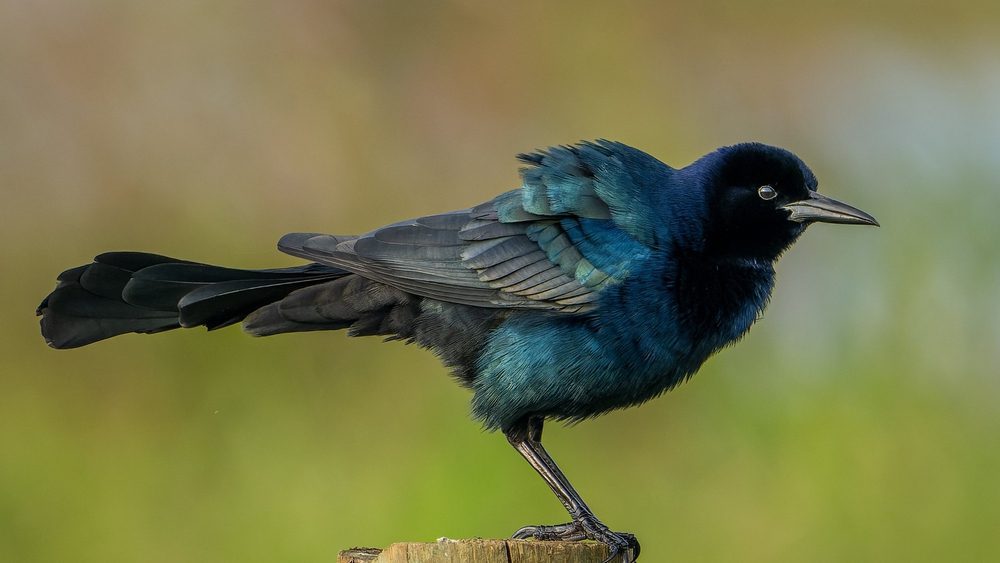
With a long tail that fans out like a boat’s stern, these birds are coastal dwellers. The Boat-tailed Grackle has a loud and distinctive call, which is hard to miss when you’re near the beach.

Boat-tailed Grackles are known for their adaptability and ability to thrive in human-altered environments. They can be found along the Atlantic and Gulf coasts of the United States, from New England down to Texas. They also inhabit freshwater wetlands, marshes, and even urban areas.
These birds are omnivorous, feeding on a variety of foods including insects, small vertebrates, seeds, and fruits. They are often seen foraging on the ground or wading in shallow water, using their long bills to search for food.
Conservation efforts for Boat-tailed Grackles focus on preserving and restoring coastal and wetland habitats. These habitats are crucial for not only grackles but also numerous other bird species and wildlife. Protecting these habitats ensures that the birds have access to food, nesting sites, and shelter.
In addition, managing human activities and minimizing disturbance in these habitats is important for the conservation of Boat-tailed Grackles. Coastal development, pollution, and habitat loss pose significant threats to these birds. By implementing measures to reduce these impacts, such as establishing protected areas and enforcing regulations, we can help maintain healthy populations of Boat-tailed Grackles.
Educating the public about the importance of coastal and wetland habitats and the role of Boat-tailed Grackles in these ecosystems is also crucial. Promoting responsible beach and wetland etiquette, such as avoiding disturbing nesting sites and disposing of trash properly, can go a long way in protecting these birds and their habitats.
By conserving the natural habitats of Boat-tailed Grackles, we can ensure the continued presence of these beautiful and charismatic birds along our coasts and wetlands. Their unique behaviors and contributions to ecosystem functioning make them an important species to appreciate and protect.
7. Great-tailed Grackle
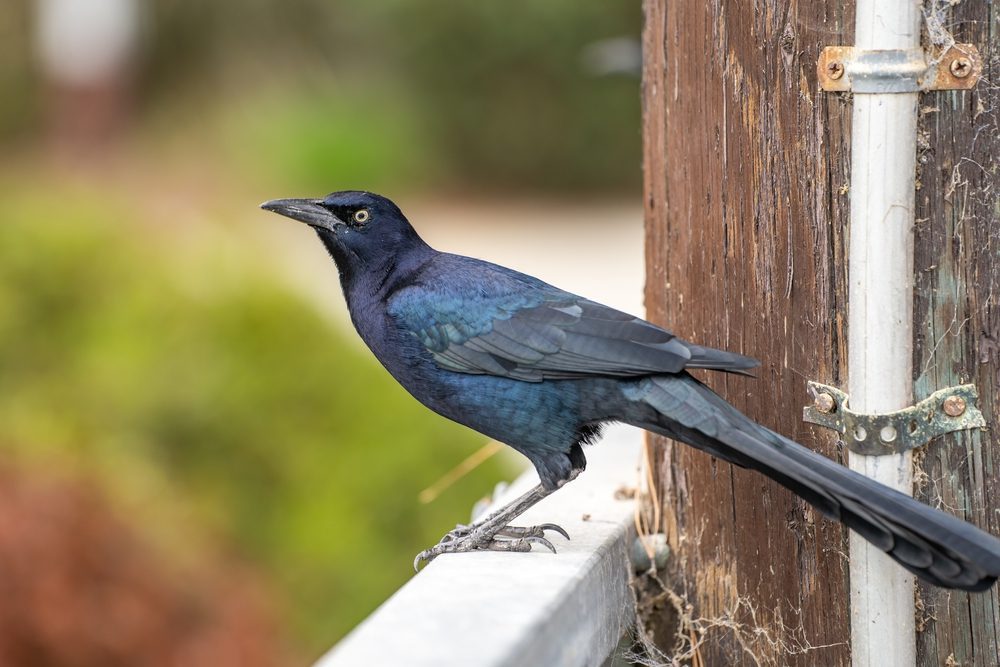
The Great-tailed Grackle’s lengthy tail and impressive size make it stand out. These social birds can often be found in noisy flocks in urban and suburban areas.

where they scavenge for food and nest in trees or man-made structures. The males of this species have glossy black feathers with purple or green iridescence, while the females have a more brownish coloration.
Great-tailed Grackles are opportunistic feeders, consuming a wide range of foods including insects, grains, fruits, and even small vertebrates. They are known to raid agricultural fields and garbage dumps in search of food. Their adaptability to urban environments has led to their widespread distribution across North and Central America.
Conservation efforts for Great-tailed Grackles often focus on managing their populations in urban areas. While these birds can be considered pests due to their habit of damaging crops and causing noise disturbances, they also play a role in controlling insect populations and dispersing seeds. Finding a balance between human needs and the preservation of these birds is important.
Providing suitable nesting sites and food sources in urban and suburban landscapes can help support Great-tailed Grackle populations. This can include installing birdhouses or structures that mimic natural nesting sites, as well as planting native vegetation that provides both shelter and food.
Educating the public about the ecological benefits of Great-tailed Grackles and promoting coexistence with these birds can also aid in their conservation. Encouraging responsible waste management and discouraging the use of harmful pesticides can help maintain a healthy environment for both humans and grackles.
By recognizing the value of Great-tailed Grackles and implementing conservation measures, we can ensure the survival of these adaptable and fascinating songbirds in our urban and suburban landscapes.
8. Yellow-headed Blackbird
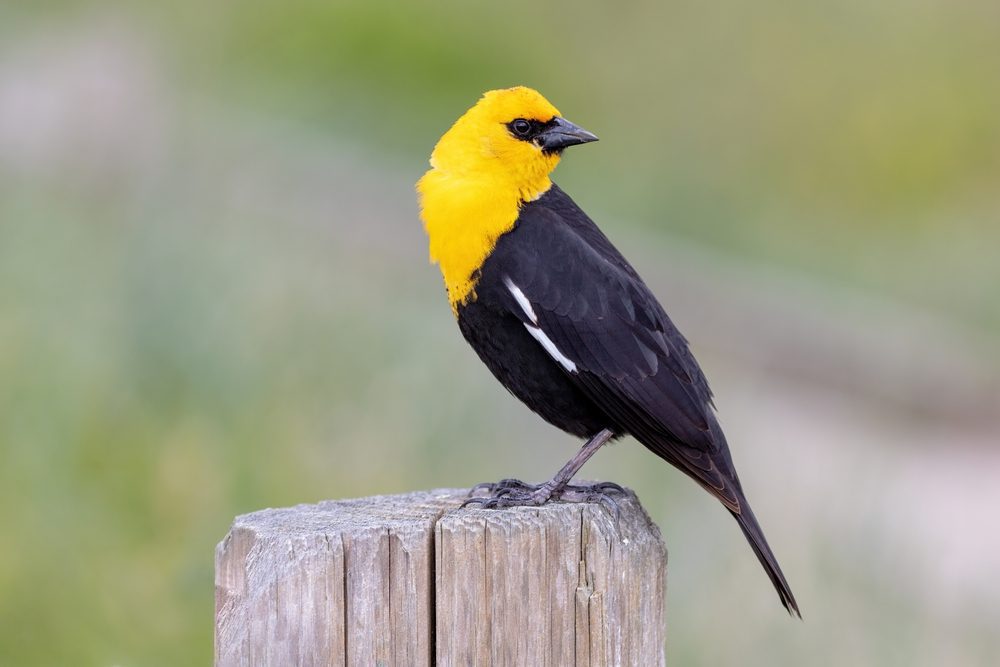
Adding a splash of color to the mix, the Yellow-headed Blackbird features a bright yellow head and chest. These birds prefer cattail marshes where their bold colors blend surprisingly well.
The Yellow-headed Blackbird is a medium-sized bird, measuring about 8 to 9 inches in length. The male has a striking yellow head and neck, contrasting with its black body and wings. Its eyes are a bright red color, adding to its overall dramatic appearance. In contrast, the female has a more subdued plumage with a streaky brown and black body.

These blackbirds inhabit wetlands and marshes across North America, particularly in the western parts of the continent. They prefer areas with dense vegetation, such as cattails, bulrushes, and other tall grasses. These habitats provide them with both nesting sites and food sources.
Yellow-headed Blackbirds are primarily insectivorous, feeding on a variety of insects found in their wetland habitats. They also consume seeds and grains, especially during the winter months when insects are scarce. They forage by perching on vegetation or on the ground, using their sharp beaks to catch prey or pick up seeds.
During the breeding season, which typically occurs from May to July, male Yellow-headed Blackbirds establish territories and attract females through courtship displays. Males will perch atop cattails or other prominent vegetation, puffing out their chests, spreading their wings, and singing loudly to advertise their presence. Their songs are a mix of harsh notes and whistles, which can carry over long distances.
Once a female is attracted, she will inspect the male’s territory and nesting site. Nests are built near or over water, usually hidden within dense vegetation. The female constructs a cup-shaped nest using grasses, reeds, and other plant materials. She then lays a clutch of 3 to 5 eggs, which she incubates for around 11 to 14 days.
Both parents participate in raising the young, feeding them a diet of insects and small invertebrates. After about 10 to 12 days, the chicks fledge and begin exploring their surroundings. They will remain dependent on their parents for a few more weeks before becoming independent.
9. Orchard Oriole
The smallest of North America’s orioles, the Orchard Oriole, brings a deeper, chestnut hue to Virginia’s black bird palette. Look for them in orchards (as their name suggests) and open woodlands during the summer.
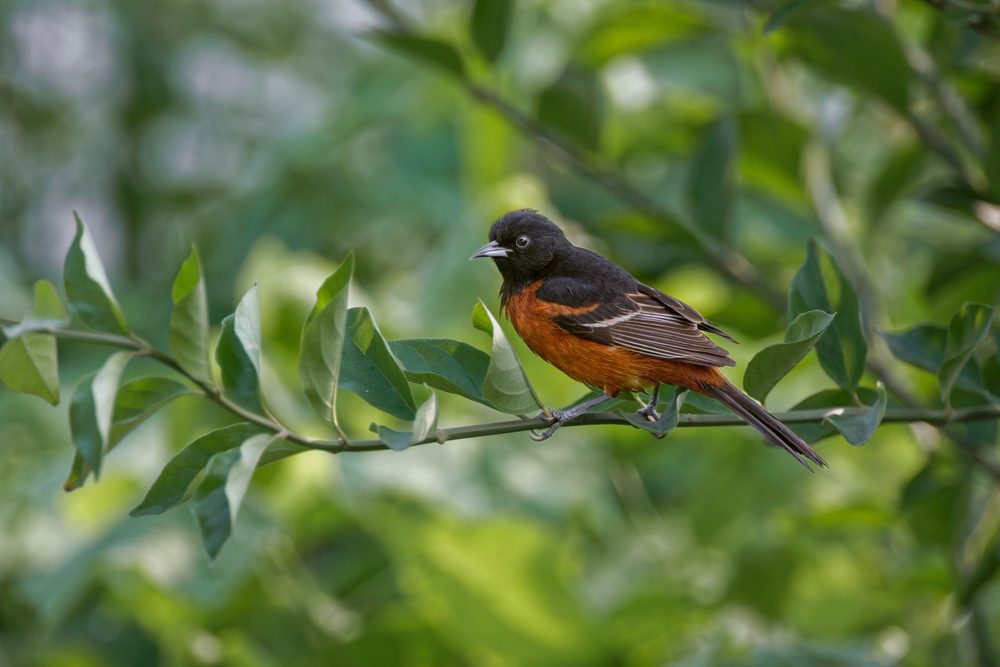
The male Orchard Oriole has a black head and upper body, with a vibrant chestnut color on its underparts. It also has white wing bars and a pointed bill. The female, on the other hand, is a duller brownish color overall.

Orchard Orioles are migratory birds, spending their winters in Central and South America. They arrive in North America in late April to early May to breed. During this time, the males establish territories and attract females through displays and songs. Their songs are a series of rich whistles and chatters.
Nesting for Orchard Orioles typically occurs in trees, particularly in orchards or open woodlands. The female builds a hanging nest made of grasses, plant fibers, and other materials. She lays a clutch of 3 to 6 eggs, which she incubates for about two weeks. Both parents participate in feeding the chicks, which fledge after about 12 to 14 days.
The diet of Orchard Orioles consists mainly of insects, but they also eat nectar, fruit, and berries. They forage by gleaning insects from leaves and branches, or by hovering to access nectar from flowers.
While the Orchard Oriole population is currently stable, they face threats from habitat loss due to deforestation and urbanization. Conservation efforts focus on preserving suitable nesting habitats and promoting the planting of native trees and shrubs to provide food sources for these beautiful birds.
10. Baltimore Oriole
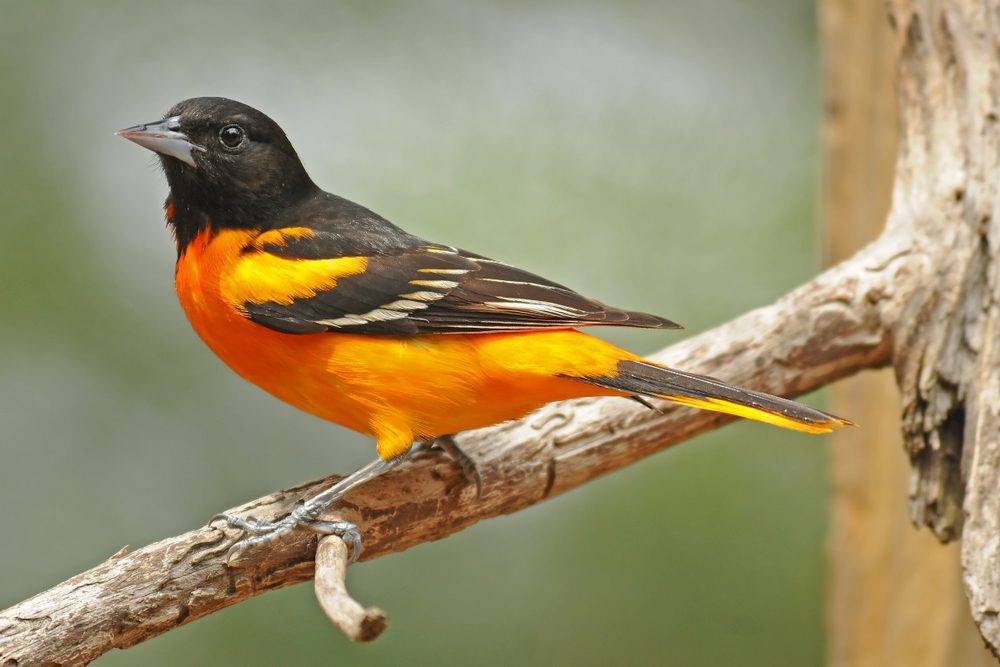
With its vivid orange and black plumage, the Baltimore Oriole is instantly recognizable. These birds weave remarkable hanging nests and are a joy to watch as they flit through the treetops.
The male Baltimore Oriole is known for its bright orange breast, belly, and undertail coverts, while its head, wings, and tail are black. It also has white wing bars and a thin, pointed bill. The female, on the other hand, has a duller yellowish-orange color on its underparts, with a grayish-brown back.

These orioles are migratory birds, spending their winters in Central and South America. They arrive in North America in late April to early May to breed. During this time, the males establish territories and attract females through elaborate courtship displays and songs. Their songs are a series of rich whistles and chatters.
Nesting for Baltimore Orioles typically occurs in trees, particularly deciduous trees like elms, maples, and willows. The female builds a hanging nest made of plant fibers, grasses, and other materials. She lays a clutch of 3 to 7 eggs, which she incubates for about two weeks. Both parents participate in feeding the chicks, which fledge after about 12 to 14 days.
The diet of Baltimore Orioles consists mainly of insects, but they also eat nectar, fruit, and berries. They forage by gleaning insects from leaves and branches, or by probing flowers for nectar. Orioles are also known to visit backyard feeders that offer fruit or jelly.
While the Baltimore Oriole population is currently stable, they face threats from habitat loss due to deforestation and urbanization. Conservation efforts focus on preserving suitable nesting habitats and promoting the planting of native trees and shrubs to provide food sources for these beautiful birds.
In conclusion, the Baltimore Oriole is a striking black bird species found in North America. Its vibrant orange and black plumage, elaborate courtship displays, and specialized habitat requirements make it an important and captivating member of our avian community.lack plumage, the Baltimore Oriole is instantly recognizable. These birds weave remarkable hanging nests and are a joy to watch as they flit through the treetops.
11. Bobolink

Bobolinks are a wonder of migration, traveling thousands of miles each year. Males are black with white backs and shoulders in the breeding season, an unusual pattern that sets them apart.

During the breeding season, male Bobolinks perform impressive aerial displays to attract females. They fly high into the sky, singing and flapping their wings in a beautiful display of courtship. Once they have found a mate, they build their nests on the ground in grassy fields or meadows.
The female Bobolink is much more inconspicuous, with a streaky brown plumage that helps her blend in with her surroundings. She lays a clutch of 4-6 eggs and incubates them for about two weeks. Both parents take turns feeding and caring for the chicks once they hatch.
In the fall, Bobolinks embark on an incredible migration journey, flying from North America to their wintering grounds in South America. Along the way, they face many challenges, including habitat loss and predation. Conservation efforts are focused on protecting their breeding habitats and raising awareness about the importance of preserving grasslands where they nest.
Overall, the Bobolink is a remarkable bird with its unique appearance and impressive migration abilities. Its presence in our ecosystems is a testament to the beauty and diversity of our avian world.
12. Eastern Meadowlark

Despite its name, the Eastern Meadowlark has more of a sunny yellow chest with a black V-shaped band. Their cheerful songs are a staple sound in grasslands and fields across Virginia.

Eastern Meadowlarks are known for their melodic and flute-like songs, which are often described as a series of clear whistles. They use their songs to establish territories and attract mates during the breeding season. Males also engage in aerial displays, flying up and then spiraling back down to the ground while singing.
These birds prefer open grasslands and meadows as their habitat, where they can find insects, seeds, and small fruits to feed on. They build their nests on the ground, hidden among tall grasses, and lay a clutch of 3-6 eggs. Both parents take turns incubating the eggs and caring for the chicks once they hatch.
Like many grassland birds, Eastern Meadowlarks face threats from habitat loss due to agricultural practices and urbanization. Conservation efforts aim to protect and restore grassland habitats, as well as promote sustainable land management practices that benefit these birds.
In conclusion, the Eastern Meadowlark is a charming bird with its sunny yellow chest and beautiful songs. Its presence in grasslands and fields adds to the vibrant tapestry of birdlife in eastern North America.
13. Brown Thrasher

The Brown Thrasher may not be entirely black, but its rich brown upperparts and streaked breast give it a dark, shadowy look. Renowned for their song repertoire, they are considered some of the most vocal birds in North America.

Brown Thrashers are primarily found in dense shrubby areas, such as woodland edges, thickets, and overgrown fields. They forage on the ground, using their long bills to flip leaf litter and debris in search of insects, berries, and seeds.
During the breeding season, male Brown Thrashers defend their territories with vigorous displays of song and aggression towards intruders. They build their nests in shrubs or low trees, constructing a cup-shaped structure made of twigs, leaves, and grass. The female lays a clutch of 3-5 eggs, which she incubates for about two weeks. Both parents participate in feeding and caring for the chicks once they hatch.
While not considered endangered, Brown Thrashers face threats from habitat loss and fragmentation, as well as pesticide use, which reduces insect populations. Conservation efforts focus on preserving and restoring suitable habitat, promoting sustainable land management practices, and raising awareness about the importance of protecting these birds.
Overall, the Brown Thrasher is a secretive and melodious bird that adds depth and character to North America’s avian community. Its unique appearance and impressive vocal abilities make it a delight to encounter in our natural landscapes.
14. American Crow
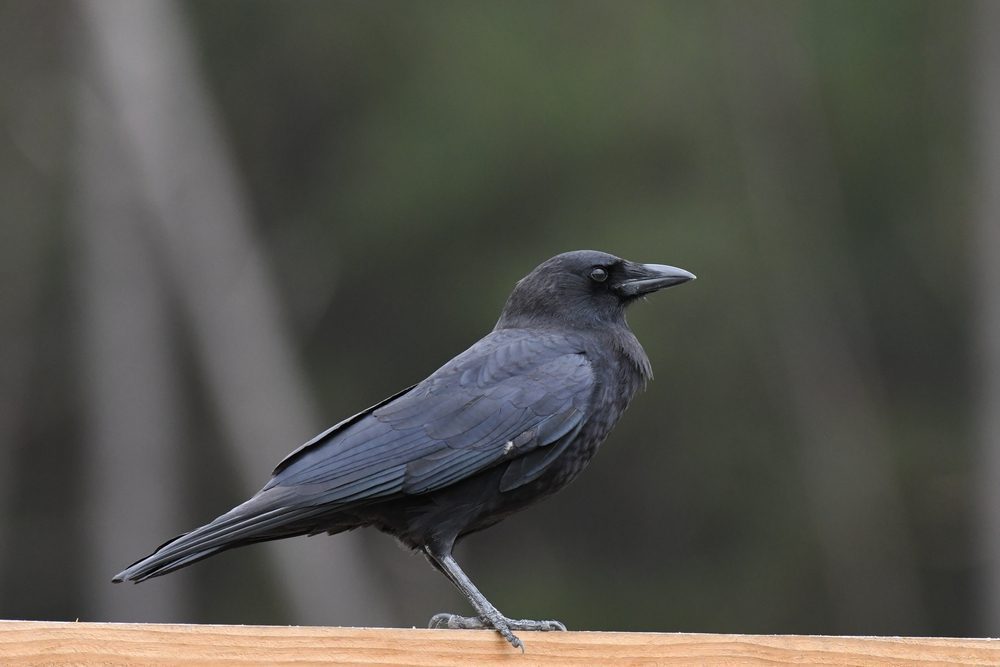
American Crows are omnivorous, feeding on a wide variety of foods including fruits, seeds, insects, carrion, and even small mammals. They use their strong beaks to forage on the ground or in trees, and they are also known to cache food in hidden locations for later consumption.

These birds are highly intelligent and have been observed using tools and problem-solving skills. They are also known to engage in cooperative hunting and mobbing behavior, where groups of crows work together to drive away predators.
During the breeding season, American Crows form monogamous pairs and build large, bulky nests made of sticks and lined with softer materials. The female lays a clutch of 3-6 eggs, which both parents incubate for about 18 days. Once the chicks hatch, both parents participate in feeding and caring for them until they fledge at around 35-40 days old.
While American Crows are not currently considered endangered, they face threats from habitat loss, pesticide use, and human persecution. Conservation efforts focus on protecting and restoring habitats, as well as raising awareness about the importance of these intelligent and adaptable birds.
15. Common Raven

Larger than crows, the Common Raven has a deep, resonating call and is known for its intelligence. These majestic birds are often associated with wilderness areas and mountainous regions.
Common Ravens are highly adaptable and opportunistic feeders. They have a varied diet that includes carrion, insects, small mammals, eggs, fruits, and even garbage. They are known for their ability to scavenge and steal food from other animals, as well as their skill in catching prey on the wing.
These birds have a complex social structure and are often seen in pairs or small groups. They engage in playful activities such as aerial acrobatics and sliding down snow slopes. They are also known for their vocal abilities, with a wide range of calls and vocalizations.
During the breeding season, Common Ravens build large nests made of sticks and lined with softer materials. The female lays a clutch of 3-7 eggs, which both parents incubate for about 18-21 days. Once the chicks hatch, both parents participate in feeding and caring for them until they fledge at around 35-42 days old.
While Common Ravens are not considered endangered, they do face threats from habitat loss, pesticide use, and human persecution. Conservation efforts focus on protecting and restoring suitable habitat, as well as raising awareness about the importance of these intelligent and charismatic birds.
In conclusion, the Common Raven is a magnificent and intelligent bird that adds a sense of mystery and awe to our avian community. Its adaptability, social structure, and vocal abilities make it a truly remarkable species.
Conclusion
Virginia’s black birds are as varied as they are fascinating. Each species adds to the rich tapestry of avian life in the state. Whether you’re a seasoned birder or new to the hobby, observing these birds can provide endless enjoyment and a deeper appreciation for nature’s diversity. Keep your eyes to the skies, and who knows what amazing black birds you might find!


